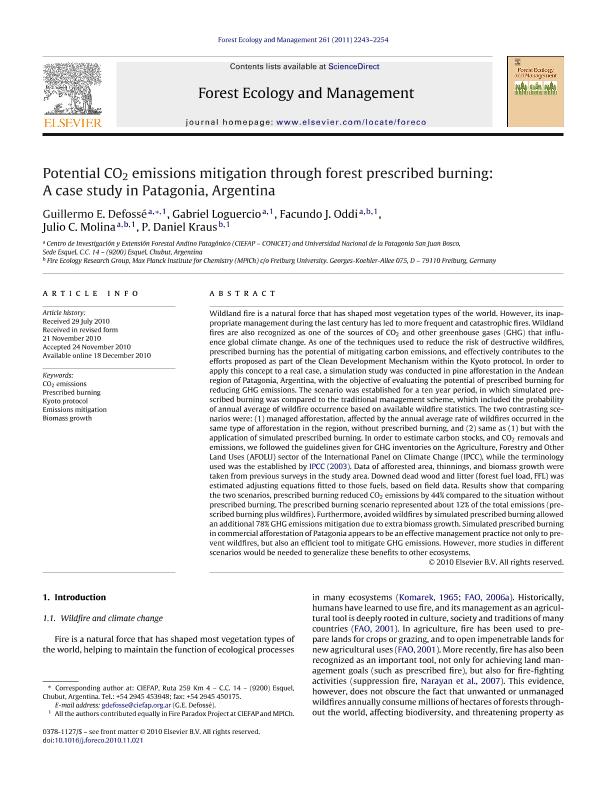Artículo
Potential CO2 emissions mitigation through forest prescribed burning: A case study in Patagonia, Argentina
Defossé, Guillermo Emilio ; Loguercio, Gabriel Angel
; Loguercio, Gabriel Angel ; Oddi, Facundo José
; Oddi, Facundo José ; Molina, Cristian Julio
; Molina, Cristian Julio ; Kraus, Daniel
; Kraus, Daniel
 ; Loguercio, Gabriel Angel
; Loguercio, Gabriel Angel ; Oddi, Facundo José
; Oddi, Facundo José ; Molina, Cristian Julio
; Molina, Cristian Julio ; Kraus, Daniel
; Kraus, Daniel
Fecha de publicación:
15/06/2011
Editorial:
Elsevier Science
Revista:
Forest Ecology and Management
ISSN:
0378-1127
Idioma:
Inglés
Tipo de recurso:
Artículo publicado
Clasificación temática:
Resumen
Wildland fire is a natural force that has shaped most vegetation types of the world. However, its inappropriate management during the last century has led to more frequent and catastrophic fires. Wildland fires are also recognized as one of the sources of CO2 and other greenhouse gases (GHG) that influence global climate change. As one of the techniques used to reduce the risk of destructive wildfires, prescribed burning has the potential of mitigating carbon emissions, and effectively contributes to the efforts proposed as part of the Clean Development Mechanism within the Kyoto protocol. In order to apply this concept to a real case, a simulation study was conducted in pine afforestation in the Andean region of Patagonia, Argentina, with the objective of evaluating the potential of prescribed burning for reducing GHG emissions. The scenario was established for a ten year period, in which simulated prescribed burning was compared to the traditional management scheme, which included the probability of annual average of wildfire occurrence based on available wildfire statistics. The two contrasting scenarios were: (1) managed afforestation, affected by the annual average rate of wildfires occurred in the same type of afforestation in the region, without prescribed burning, and (2) same as (1) but with the application of simulated prescribed burning. In order to estimate carbon stocks, and CO2 removals and emissions, we followed the guidelines given for GHG inventories on the Agriculture, Forestry and Other Land Uses (AFOLU) sector of the International Panel on Climate Change (IPCC), while the terminology used was the established by IPCC (2003). Data of afforested area, thinnings, and biomass growth were taken from previous surveys in the study area. Downed dead wood and litter (forest fuel load, FFL) was estimated adjusting equations fitted to those fuels, based on field data. Results show that comparing the two scenarios, prescribed burning reduced CO2 emissions by 44% compared to the situation without prescribed burning. The prescribed burning scenario represented about 12% of the total emissions (prescribed burning plus wildfires). Furthermore, avoided wildfires by simulated prescribed burning allowed an additional 78% GHG emissions mitigation due to extra biomass growth. Simulated prescribed burning in commercial afforestation of Patagonia appears to be an effective management practice not only to prevent wildfires, but also an efficient tool to mitigate GHG emissions. However, more studies in different scenarios would be needed to generalize these benefits to other ecosystems.
Archivos asociados
Licencia
Identificadores
Colecciones
Articulos(INIBIOMA)
Articulos de INST. DE INVEST.EN BIODIVERSIDAD Y MEDIOAMBIENTE
Articulos de INST. DE INVEST.EN BIODIVERSIDAD Y MEDIOAMBIENTE
Articulos(SEDE CENTRAL)
Articulos de SEDE CENTRAL
Articulos de SEDE CENTRAL
Citación
Defossé, Guillermo Emilio; Loguercio, Gabriel Angel; Oddi, Facundo José; Molina, Cristian Julio; Kraus, Daniel; Potential CO2 emissions mitigation through forest prescribed burning: A case study in Patagonia, Argentina; Elsevier Science; Forest Ecology and Management; 261; 12; 15-6-2011; 2243-2254
Compartir
Altmétricas



